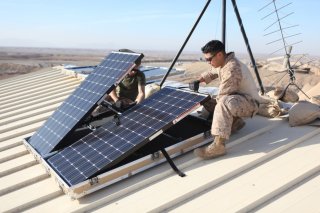The U.S. Army Aims to Protect Its Installations From Climate Change
Climate variables that impact Army installations are a specific focus of the Army's new climate strategy.
Citing the national security threats associated with floods, extreme storms, melting ice, and destabilizing heat, the U.S. Army’s recently published climate strategy outlines an ambitious series of adjustments to combat the impact of climate change.
The strategy calls for the Army to pursue electric vehicles, new sources of renewable energy, extreme weather mitigation strategies, and technologies to protect Army installations around the world.
For example, the Army’s strategy calls for the installation of a microgrid on every installation by 2035. The Army also plans to achieve “on-site carbon pollution-free power generation for Army critical missions on all installations by 2040.” Other benchmarks outlined in the strategy include a 50 percent reduction in greenhouse gas (GHG) emissions from all Army buildings by 2032 and “net-zero GHG emissions from Army installations by 2045.”
Paul Farnan, Assistant Secretary of the Army for Installations, Energy, and Environment, told reporters that ensuring Army installations are resilient against the impacts of climate change will protect the United States’ ability to project power globally.
Many of the stated goals in the strategy will become much more achievable if the Army succeeds in installing a microgrid to provide carbon-free energy at every installation. There are a number of other ways that Army innovators could increase energy efficiency and streamline the storage and distribution of power throughout large facilities. Notably, generators and installation-based power storage systems can improve performance while drastically lowering the necessary amount of electrical power storage and output.
For example, the U.S. Navy is using software and consolidated energy storage and distribution systems to power multiple nodes on a ship from a single power source of stored energy. This Integrated Power and Energy System (IPES) is now being developed for ships such as the new DDG X destroyer. While the technology is currently only used by the Navy, this kind of carbon footprint-reducing energy storage system might have relevant applications for land installations as well.
Climate and land configuration variables that impact Army installations will be another specific area of focus. The strategy calls for the Army to “include climate change threat mitigation into Army land management decisions” and “incorporate the latest climate and environmental science into stationing, construction, and fielding decisions.”
The strategy also recognizes the need to ensure the physical security and functionality of land bases that may be threatened by extreme weather conditions. “The Army will face simultaneous readiness challenges as units contend with limited access at flooded bases, alongside increased water scarcity and land degradation in other areas,” the report says.
What if unexpected rainfall or storms create dangerous flooding on a high-value forward operating base or installation? In order to mitigate this threat, the strategy calls for base planners and builders to account for these variables when deciding where and how to build new facilities. Bases may be built on higher ground with additional reinforcements to mitigate the risk of flood damage.
While the Army is only beginning its efforts to counter the national security threats posed by climate change, this strategy is an important first step.
Kris Osborn is the Defense Editor for the National Interest. Osborn previously served at the Pentagon as a Highly Qualified Expert with the Office of the Assistant Secretary of the Army—Acquisition, Logistics & Technology. Osborn has also worked as an anchor and on-air military specialist at national TV networks. He has appeared as a guest military expert on Fox News, MSNBC, The Military Channel, and The History Channel. He also has a Master's Degree in Comparative Literature from Columbia University.
Image: Reuters.

